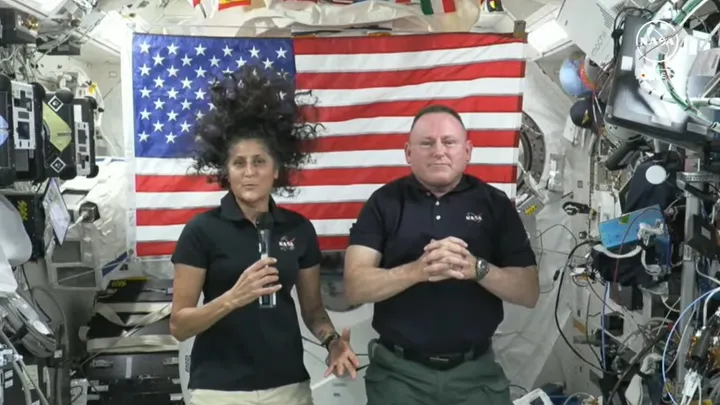NASA astronauts Suni Williams and Butch Wilmore will not be returning to earth with the Boeing Starliner spacecraft that shuttled them to the International Space Station. (NASA)
NASA announced on Saturday, August 24, 2024, that the troubled Boeing Starliner spacecraft, which has been carrying astronauts Butch Wilmore and Suni Williams since June, will return to Earth without them on board. This unexpected turn of events followed a series of technical problems that were discovered shortly after the Starliner docked with the International Space Station (ISS). These issues, including helium leaks and thruster malfunctions, raised concerns about the spacecraft’s ability to safely bring the astronauts back home.
The decision to bring the spacecraft back to Earth without its crew was made after NASA and Boeing engineers thoroughly analyzed the situation. The focus was on ensuring the safety of the astronauts, and it was ultimately decided that the risks of a crewed return were too high. Instead, the spacecraft will conduct an uncrewed return, which will allow NASA and Boeing to continue collecting valuable testing data without jeopardizing the astronauts’ safety.
Wilmore and Williams initially launched from Florida’s Cape Canaveral Space Force Station on June 5, 2024, on a test flight that was only supposed to last a week. The mission, however, quickly encountered difficulties, with the technical issues becoming apparent just two days into the flight. Despite these problems, the astronauts have remained safe aboard the ISS, with NASA ensuring they have everything they need for their extended stay.
NASA Administrator Bill Nelson emphasized the agency’s commitment to safety, stating, “Our decision to keep Butch and Suni aboard the ISS and bring Boeing’s Starliner home uncrewed is driven by our unwavering commitment to the safety of our astronauts.” He expressed gratitude to both NASA and Boeing teams for their meticulous work in managing the situation and developing a plan for the spacecraft’s return.
With the Starliner no longer considered a safe option for the astronauts, NASA has turned to its partner, SpaceX, for assistance. Wilmore and Williams are now set to return to Earth aboard a SpaceX Crew-9 Dragon mission, which is currently scheduled to launch no earlier than September 24, 2024. The SpaceX spacecraft will need to reduce its crew size from four to two to accommodate the stranded astronauts. Additionally, the mission will carry special Dragon-specific spacesuits for Wilmore and Williams, as their Boeing spacesuits are not compatible with the SpaceX vehicle.
This delay means that the astronauts are not expected to return to Earth until February 2025, extending their time in space far beyond what was originally planned. Despite the challenges, NASA and Boeing are committed to learning from this experience, using the data collected during the uncrewed return to improve the Starliner for future missions.
In the meantime, NASA and Boeing engineers continue to work tirelessly, poring over data and conducting tests to determine the best course of action for the Starliner program moving forward. They have also developed various contingency plans to ensure the astronauts’ safe return and prevent any further complications.
Steve Stich, manager of NASA’s Commercial Crew Program, expressed confidence in the Starliner’s capabilities, noting that the spacecraft has completed two uncrewed flights in the past. He added, “This flight test is providing critical information on Starliner’s performance in space, and our efforts will help ensure future corrective actions for the spacecraft.”
The Boeing Starliner is expected to undock from the ISS and begin its autonomous return to Earth in early September. While this flight will be uncrewed, it is a crucial step in gathering more data and fine-tuning the spacecraft for future missions. Despite the setbacks, both NASA and Boeing remain optimistic about the future of the Starliner program, with hopes that this experience will lead to improvements that will benefit future astronauts.
As NASA and its commercial partners continue to push the boundaries of space exploration, incidents like these serve as important reminders of the challenges and risks involved in human spaceflight. But with each setback comes an opportunity for growth and learning, paving the way for safer and more successful missions in the future.
Wilmore and Williams, meanwhile, will continue their mission aboard the ISS, awaiting their eventual return to Earth aboard SpaceX’s Dragon spacecraft. Though their journey has taken an unexpected turn, their experience underscores the resilience of both the astronauts and the teams supporting them from the ground.
#NASAMissions #BoeingStarliner #SpaceExploration #AstronautLife #SpaceXRescue
